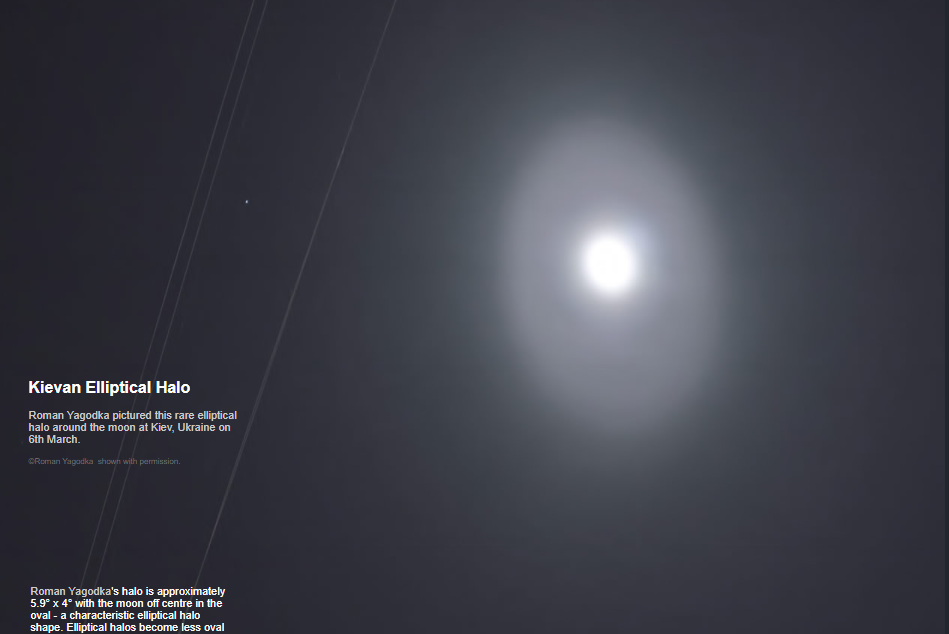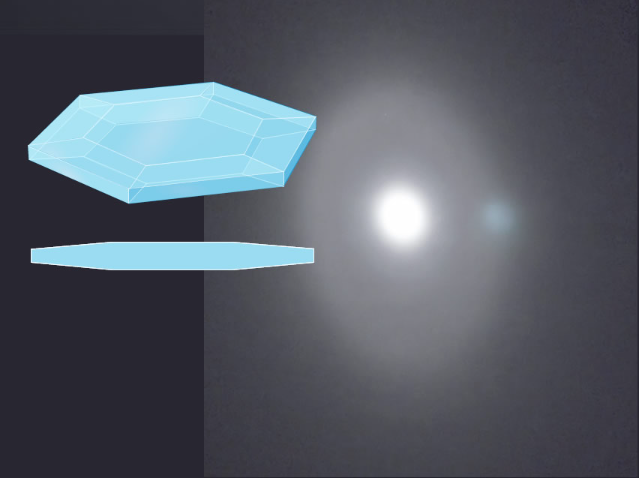OPOD - Kievan Elliptical Halo
OPOD - Kievan Elliptical Halo: A Rare Atmospheric Phenomenon
Have you ever heard of the Kievan Elliptical Halo? It's a fascinating atmospheric phenomenon that was captured by Roman Yagodka in Kiev, Ukraine on 6th March. This rare halo appears as an oval shape around the moon, creating a stunning visual display in the night sky.
The Kievan Elliptical Halo observed by Roman Yagodka had an approximate size of 5.9° x 4°, with the moon slightly off-center within the oval shape. This characteristic elliptical halo shape is known to change its ovalness as the altitude of the moon or sun increases. In this particular instance, the moon was at an elevation of 39°. To the left of the moon, you can also spot the bright star Regulus, adding to the celestial spectacle.
One of the possible causes of these halos is the presence of pyramidal crystals with crystallographically improbable shapes. These crystals, when present in the atmosphere, can create various ray paths that generate oval arcs. However, it is important to note that ray tracing simulations are not always able to fully explain the complexity and intricacy of these atmospheric phenomena.
To capture this mesmerizing event, Roman Yagodka used a camera with a 1/8s exposure at f/4 and ISO 3200 settings. The equivalent 35mm focal length was 75mm, allowing him to capture the details of the elliptical halo with precision.
It's worth mentioning that this article has been automatically converted from the old site and may not appear as intended. However, the original article can be found here for reference.
In conclusion, witnessing the Kievan Elliptical Halo is a truly remarkable experience. Its unique oval shape adds an element of mystery and beauty to the night sky. While the exact mechanisms behind the formation of these halos are still not fully understood, they serve as a reminder of the countless wonders that nature has to offer. So, keep your eyes to the sky, as you never know when you might catch a glimpse of this elusive atmospheric phenomenon.

Kievan Elliptical Halo
Roman Yagodka pictured this rare elliptical halo around the moon at Kiev, Ukraine on 6th March.
©Roman Yagodka shown with permission.
Roman Yagodka's halo is approximately 5.9° x 4° with the moon off centre in the oval - a characteristic elliptical halo shape. Elliptical halos become less oval as the moon or sun increases in altitude. Here the moon was 39° high. The star to the left is Regulus.
The halos might be generated by varieties of the crystallographically rather improbable pyramidal crystal at right.
Several ray paths between its faces can generate oval arcs. However, ray tracing simulations are never fully satisfactory.
Roman used a 1/8s exposure at f/4 and ISO 3200, equivalent 35mm focal length of 75mm.

Note: this article has been automatically converted from the old site and may not appear as intended. You can find the original article here.
Reference Atmospheric Optics
If you use any of the definitions, information, or data presented on Atmospheric Optics, please copy the link or reference below to properly credit us as the reference source. Thank you!
-
<a href="https://atoptics.co.uk/blog/opod-kievan-elliptical-halo/">OPOD - Kievan Elliptical Halo</a>
-
"OPOD - Kievan Elliptical Halo". Atmospheric Optics. Accessed on November 26, 2024. https://atoptics.co.uk/blog/opod-kievan-elliptical-halo/.
-
"OPOD - Kievan Elliptical Halo". Atmospheric Optics, https://atoptics.co.uk/blog/opod-kievan-elliptical-halo/. Accessed 26 November, 2024
-
OPOD - Kievan Elliptical Halo. Atmospheric Optics. Retrieved from https://atoptics.co.uk/blog/opod-kievan-elliptical-halo/.